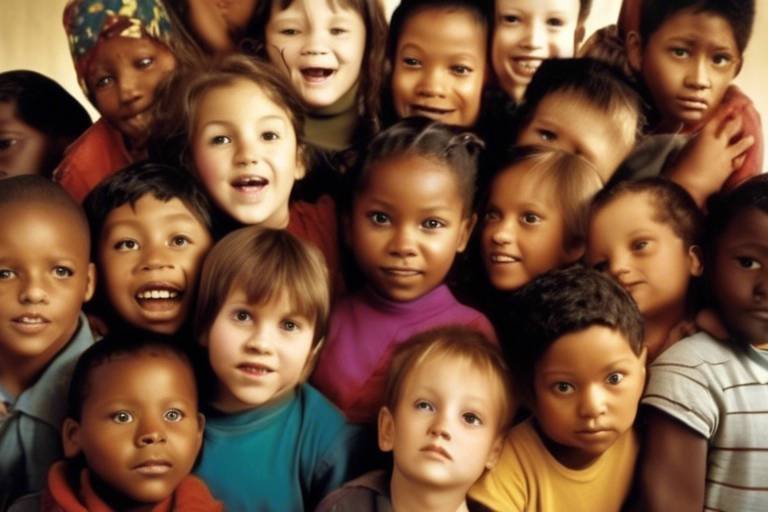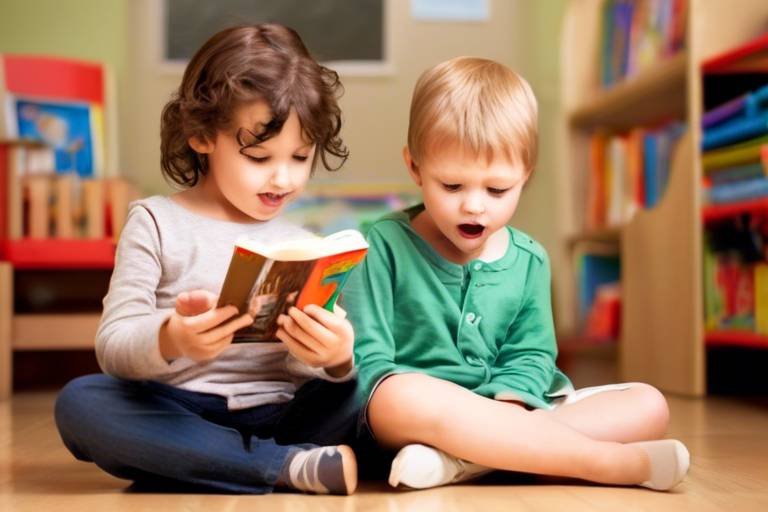Understanding The Different Stages Of Child Development
Child development is a fascinating journey that unfolds in various stages, each with its unique milestones and challenges. Understanding these stages is not just for parents; it's essential for anyone involved in a child's life, including educators, caregivers, and even the community. Each phase of development plays a critical role in shaping a child's future, influencing their emotional, social, and cognitive growth. By recognizing the importance of these stages, we can better support children as they navigate the complexities of growing up.
From the moment a child is born, they are on a path of discovery and learning. The experiences they encounter during these formative years lay the groundwork for their entire lives. Think of it like building a house; without a strong foundation, the structure may crumble. In this article, we will explore the different stages of child development, highlighting key milestones, emotional growth, cognitive abilities, and the importance of nurturing environments in shaping a child's future. So, whether you're a parent looking for guidance or simply curious about child development, let's dive in!
Infancy is a crucial period where physical growth and sensory experiences lay the groundwork for future development. During this stage, babies undergo rapid changes, both physically and cognitively. They learn to recognize faces, respond to sounds, and begin to develop their motor skills. Understanding this stage helps caregivers provide appropriate stimulation and care. For instance, engaging with infants through talking, singing, and playing can significantly enhance their sensory development.
As children transition into early childhood, they begin to explore the world around them more actively. This stage is characterized by the development of language skills and social interactions. Children learn to express themselves verbally, which opens up a whole new world of communication. Play becomes a vital part of their learning process, fostering creativity and independence. It's during this time that children start to form friendships and learn the basics of cooperation and sharing, which are essential for their emotional and social development.
In middle childhood, children refine their cognitive and social skills. This stage is often marked by increased independence and a deeper understanding of their emotions and the world around them. Friendships become more significant, and children learn to navigate the complexities of social dynamics. They also begin to develop a sense of self, which is crucial for their self-esteem and confidence. Parents and educators play a key role in supporting children through this phase, helping them build resilience and problem-solving skills.
Adolescence is a time of significant change, filled with both challenges and opportunities. Teens experience rapid physical, emotional, and social transformations. They begin to form their identities and explore their independence, which can sometimes lead to conflicts with authority figures. Understanding this stage is essential for supporting teens as they navigate complex relationships and emotional upheavals. Open communication and a supportive environment can make a world of difference during this tumultuous time.
Parenting styles significantly influence child development. From authoritative to permissive, each approach has its unique impact on children's emotional and social growth. For example, children raised in nurturing environments tend to develop better emotional regulation and social skills. It's essential for parents to be aware of their parenting style and its effects on their child's development. A balanced approach that combines love, discipline, and guidance can foster healthy development.
A child's environment plays a pivotal role in their development. Factors such as socioeconomic status, education, and community resources can significantly affect a child's growth trajectory. For instance, children from enriched environments with access to educational resources and supportive communities often demonstrate better cognitive and emotional outcomes. It's crucial for society to recognize and address these disparities to ensure that all children have the opportunity to thrive.
Recognizing developmental milestones is crucial for parents and educators. These milestones serve as benchmarks to monitor a child's growth and development. Key milestones across various stages include:
- Infancy: Rolling over, sitting up, and crawling.
- Early Childhood: Speaking in sentences, playing cooperatively, and following simple instructions.
- Middle Childhood: Developing friendships, understanding rules, and improving academic skills.
- Adolescence: Establishing identity, forming deeper relationships, and developing critical thinking skills.
By being aware of these milestones, caregivers can address any concerns early on and provide the necessary support to help children reach their full potential.
Children may face various challenges that can hinder their development. Developmental disorders, such as ADHD, autism, and learning disabilities, can impact a child's ability to thrive. Early intervention and support are crucial in these cases. Recognizing the signs of developmental delays and seeking help from professionals can make a significant difference in a child's life. It’s essential to create an environment where children feel safe and supported in overcoming these challenges.
Supporting healthy child development involves collaboration between parents, educators, and healthcare providers. Strategies to promote well-being and resilience in children include:
- Encouraging open communication and emotional expression.
- Providing a stable and nurturing environment.
- Promoting physical activity and healthy eating.
- Engaging in educational activities that stimulate cognitive development.
By working together, we can create a supportive network that fosters healthy development and empowers children to reach their full potential.
Q: What are the key stages of child development?
A: The key stages of child development include infancy, early childhood, middle childhood, and adolescence. Each stage has its unique milestones and challenges.
Q: How can I support my child's development?
A: Supporting your child's development involves providing a nurturing environment, encouraging open communication, and engaging in activities that promote learning and emotional well-being.
Q: What should I do if I notice developmental delays in my child?
A: If you notice developmental delays, it's important to seek help from professionals. Early intervention can significantly improve outcomes for children with developmental challenges.

Infancy: The Foundation of Development
Infancy is a crucial period in a child's life, laying the groundwork for all future development. During these early months and years, a baby's brain undergoes rapid growth, forming millions of neural connections that will shape their cognitive abilities, emotional responses, and social skills. Imagine a tiny seed sprouting in a garden; with the right amount of sunlight, water, and care, it can grow into a strong tree. Similarly, infants require a nurturing environment filled with love, stimulation, and security to thrive.
In this stage, physical growth is paramount. Babies experience significant changes in their weight and height, often doubling their birth weight by six months and tripling it by their first birthday. This physical development is closely tied to sensory experiences. Infants explore the world through their senses, and caregivers play a vital role by providing a variety of stimuli. Think of it as creating a rich tapestry of experiences; the more colors and textures you add, the more vibrant the picture becomes.
Key milestones during infancy include:
- Motor Skills: From grasping a finger to crawling and eventually walking, each movement is a stepping stone in their physical development.
- Language Development: Infants begin to coo and babble, laying the foundation for future language skills. These early sounds are not just random noises; they are the beginnings of communication.
- Social Interaction: The first smiles and laughs are more than just adorable; they signal the infant's growing social awareness and ability to connect with others.
Understanding these milestones helps caregivers provide the appropriate stimulation and care needed during this formative stage. For instance, engaging in simple games like peek-a-boo or reading colorful picture books can enhance sensory experiences and promote bonding. Such activities not only entertain but also encourage cognitive and emotional growth.
Moreover, the emotional environment during infancy is equally important. Babies are incredibly sensitive to their surroundings and the emotional states of their caregivers. A warm, responsive, and loving atmosphere fosters a sense of security, allowing infants to explore their world with confidence. Conversely, a stressful or neglectful environment can hinder development, leading to long-term emotional and behavioral issues.
In conclusion, infancy is not just about physical growth; it's about nurturing the whole child. By providing a stimulating and loving environment, caregivers can set the stage for a lifetime of learning and emotional health. As we move forward in this exploration of child development, let’s remember that the seeds planted during infancy will shape the future of these little ones.

Early Childhood: Exploring the World
Early childhood is a magical time in a child's life, filled with discovery and wonder. During these formative years, typically ranging from ages 2 to 6, children embark on an exciting journey of exploration that shapes their understanding of the world. This stage is not just about learning to walk or talk; it’s about developing critical skills that will serve as the foundation for their future growth.
One of the most remarkable aspects of early childhood is the rapid development of language skills. Children begin to string words together, forming simple sentences and expressing their thoughts and feelings. This newfound ability to communicate opens up a world of possibilities. Imagine a toddler who, just a few months ago, could only point to what they wanted, now joyfully sharing their favorite story or describing the world around them. This is the stage where vocabulary expands like a balloon, and parents can encourage this growth by engaging in conversations, reading books, and singing songs.
Equally important during early childhood is the child's growing sense of independence. As they explore their environment, children begin to assert their autonomy, often leading to the classic phrase, “I can do it myself!” This is a crucial part of their development, as it fosters confidence and self-reliance. From dressing themselves to choosing their snacks, these small acts of independence contribute to their overall self-esteem. Caregivers can support this independence by providing opportunities for children to make choices and solve problems on their own.
Play is the heart of early childhood development. Through play, children learn about social interactions, cooperation, and even conflict resolution. It’s in these moments of play that they develop their social skills, learning to share, take turns, and communicate effectively with peers. Whether it's building a fort out of pillows or engaging in imaginative role-play, each activity serves as a stepping stone in their social journey. Parents and educators can enhance this experience by creating a nurturing environment that encourages creativity and exploration.
Moreover, emotional growth is a significant aspect of this stage. Children begin to understand their own feelings and those of others. They learn to express emotions in healthy ways, paving the way for empathy and compassion. For instance, when a child comforts a friend who has fallen or shares a toy with someone in distress, they are not just playing; they are learning to navigate the complex world of emotions. This emotional intelligence is vital for building relationships and fostering a sense of community.
As children explore their world, it’s essential to recognize the role of nurturing environments. A supportive atmosphere, filled with love and encouragement, allows children to thrive. Caregivers should strive to provide a safe space where curiosity is celebrated, and mistakes are viewed as opportunities for learning. This approach not only boosts their confidence but also ignites a lifelong passion for learning.
In summary, early childhood is a vibrant tapestry of exploration, learning, and emotional growth. It’s a time when children are like sponges, soaking up everything around them. By fostering language skills, promoting independence, encouraging play, and nurturing emotional intelligence, parents and caregivers can set the stage for a bright future. So, let’s embrace this journey together, as we help our little ones explore the world and all its wonders!
- What are the key milestones in early childhood development?
Key milestones include language development, social skills, emotional understanding, and motor skills. Each child develops at their own pace, but these are common areas of growth during this stage.
- How can I support my child's independence?
Encourage your child to make choices, offer them opportunities to try new things, and praise their efforts. Allow them to tackle simple tasks on their own, which can boost their confidence.
- Why is play important in early childhood?
Play is essential for cognitive, social, and emotional development. It helps children learn problem-solving skills, enhances creativity, and fosters social interactions.

Middle Childhood: Building Skills and Relationships
Middle childhood, typically ranging from ages 6 to 12, is a fascinating and dynamic period in a child's life. During these years, children are like sponges, absorbing everything around them as they refine their cognitive abilities and develop essential social skills. This stage is akin to a building site, where the foundations laid in earlier years are strengthened, and new structures are erected. It's a time when kids start to understand the world beyond their immediate family, forging friendships and learning the art of cooperation.
As children engage with peers, they begin to navigate the complexities of social interactions. They learn to share, take turns, and resolve conflicts—skills that are crucial for their emotional and social development. Imagine these interactions as a dance, where each child learns the steps of communication and empathy. The ability to express feelings and understand others is like the rhythm that keeps the dance flowing smoothly.
Academically, this stage is equally significant. Children start to develop a deeper understanding of subjects such as math and reading. They transition from learning to read to reading to learn, which opens up new worlds of knowledge and imagination. It's a period where curiosity is often at its peak, and parents and educators can nurture this by providing stimulating environments filled with books, educational games, and creative activities.
Moreover, the friendships formed during middle childhood are often some of the most impactful. These relationships teach children about loyalty, trust, and the importance of being part of a community. Kids may engage in group activities, sports, or clubs, which not only build their social skills but also enhance their sense of belonging. Here’s a quick look at some key aspects of friendships during this stage:
| Aspect | Description |
|---|---|
| Cooperation | Children learn to work together toward common goals, whether in games or group projects. |
| Conflict Resolution | They develop skills to resolve disagreements amicably, fostering emotional intelligence. |
| Empathy | Understanding and sharing the feelings of others becomes more pronounced. |
However, the journey through middle childhood isn't always smooth sailing. Children may face challenges such as peer pressure or academic stress, which can impact their self-esteem and relationships. It's crucial for parents and caregivers to maintain open lines of communication, offering support and guidance during these turbulent times. Encouraging children to express their feelings and concerns can help them navigate these challenges effectively.
In summary, middle childhood is a pivotal stage where children build essential skills and relationships that will serve them for a lifetime. By fostering a supportive environment filled with love, encouragement, and opportunities for social interaction, we can help children flourish during this critical period of development.
- What are the key developmental milestones in middle childhood? Children typically develop improved language skills, emotional regulation, and the ability to form complex social relationships during this stage.
- How can parents support their child's social development? Parents can encourage playdates, team sports, and group activities to enhance social skills and relationships.
- What role does school play in middle childhood development? Schools provide structured environments for learning and social interaction, crucial for cognitive and emotional growth.

Adolescence: Navigating Change
Ah, adolescence—the rollercoaster ride of life! This stage is not just a transition; it’s a whirlwind of physical, emotional, and social changes that can leave both teens and their parents feeling a bit dizzy. Imagine standing at the edge of a cliff, about to dive into the unknown waters below. That's what adolescence feels like for many young people. They are on the brink of adulthood, but still tethered to the innocence of childhood. This delicate balance creates a unique set of challenges and opportunities.
During adolescence, teenagers experience rapid changes in their bodies, leading to a surge of hormones that can affect their mood and behavior. This is the time when they start to question everything—authority, friendships, and even their own identity. It’s a period where they are trying to find their place in the world, often feeling like a ship lost at sea. They might ask themselves, "Who am I?" and "Where do I fit in?" These questions are crucial as they begin to shape their self-image and personal values.
Social dynamics also shift dramatically during these years. Friendships become more complex, and peer influence can be both a blessing and a curse. Teens often find themselves navigating the tricky waters of peer pressure, trying to balance their desire for acceptance with their own beliefs and values. This can lead to a variety of experiences, from forming strong bonds to dealing with conflict. The importance of a supportive social circle cannot be overstated; it can make all the difference in a teen’s emotional well-being.
Education plays a pivotal role during adolescence as well. As teens progress through school, they encounter new academic challenges that require greater independence and critical thinking skills. They are not just learning facts; they are learning how to learn. This is where they can begin to discover their passions and interests, which can serve as a guiding light for their future careers. However, with increased academic pressure comes the potential for stress and anxiety, making it essential for parents and educators to provide support and understanding.
To help navigate these tumultuous waters, it’s crucial for caregivers to establish open lines of communication. Here are some tips for fostering a supportive environment:
- Listen actively: Show genuine interest in what your teen has to say.
- Be non-judgmental: Create a safe space for them to express their feelings.
- Encourage independence: Allow them to make choices and learn from their mistakes.
In conclusion, adolescence is a transformative period filled with challenges and opportunities. By understanding the changes that occur during this stage, parents and caregivers can better support their teens as they navigate this complex journey. Just like a butterfly emerging from its cocoon, adolescents are undergoing a metamorphosis that will shape their future selves. With the right guidance and support, they can spread their wings and soar!
Q: What are the main changes a teenager goes through during adolescence?
A: Teenagers experience significant physical growth, hormonal changes, and emotional fluctuations. They also navigate complex social dynamics and increased academic pressures.
Q: How can parents support their teens during this time?
A: Open communication, active listening, and providing a safe environment for expression are key. Encouraging independence while offering guidance can also help.
Q: What role do peers play in adolescent development?
A: Peers significantly influence teenagers' social behavior, self-esteem, and decision-making. Positive peer relationships can enhance emotional well-being, while negative influences can pose challenges.

The Role of Parenting in Development
When it comes to child development, the role of parenting cannot be overstated. Parents are the first teachers, mentors, and role models that children encounter. The way they interact with their children, the values they instill, and the environment they create can significantly shape a child's emotional and social growth. Think of parenting as the soil in which a plant grows; if the soil is rich and nurturing, the plant will flourish. Conversely, poor soil can stunt growth and development.
Research shows that different parenting styles can lead to varying outcomes in children's behavior and emotional well-being. Here are four primary styles of parenting and their potential impacts:
| Parenting Style | Description | Potential Impact on Child |
|---|---|---|
| Authoritative | Characterized by warmth, responsiveness, and high expectations. | Children tend to be confident, socially skilled, and perform well academically. |
| Authoritarian | High demands with low responsiveness; strict rules and expectations. | Children may become obedient but can struggle with self-esteem and social skills. |
| Permissive | Warmth and indulgence with few rules or expectations. | Children may struggle with self-discipline and authority but can be creative and expressive. |
| Neglectful | Low responsiveness and low demands; lack of involvement. | Children may experience emotional and behavioral issues, feeling unloved or unimportant. |
Each of these styles can impact a child’s development in unique ways. For instance, children raised in an authoritative environment often exhibit better emotional regulation and social competence. This is because authoritative parents encourage open communication, allowing children to express their feelings and thoughts. In contrast, authoritarian parenting may lead to children who are less likely to voice their concerns, potentially leading to internalized stress.
Moreover, it's important to recognize that parenting is not a one-size-fits-all approach. Each child is unique, with their own personality and needs. Parents must be adaptable, responding to their child's cues and adjusting their approach as necessary. This adaptability is crucial in fostering a child's sense of security and self-worth.
Additionally, the emotional connection between a parent and child lays the groundwork for healthy relationships in the future. When parents are emotionally available and responsive, children learn to trust others and form secure attachments. This emotional foundation is essential for navigating friendships, romantic relationships, and even professional interactions later in life.
In conclusion, parenting is a multifaceted role that significantly influences a child's development. By understanding the impact of different parenting styles and fostering a nurturing environment, parents can help their children thrive. It’s not just about setting rules; it’s about building a supportive framework that allows children to explore, learn, and grow into well-rounded individuals.
- What is the most effective parenting style? The authoritative style is often considered the most effective, as it balances warmth and structure.
- How can I adapt my parenting style? Observe your child's behavior and needs, and be willing to adjust your approach based on their responses.
- What role does a father's involvement play? A father's active participation in parenting can enhance a child's emotional and social development.

The Impact of Environment on Development
The environment in which a child grows up plays a pivotal role in shaping their developmental trajectory. From the moment they are born, children are influenced by their surroundings—be it their home, community, or even the broader societal context. Imagine a plant growing in a garden; if the soil is rich and well-maintained, the plant thrives. Conversely, if the environment is barren or toxic, growth is stunted. This analogy holds true for children as well.
Various factors contribute to a child's environment, and understanding these can help caregivers create a nurturing space. For instance, socioeconomic status can significantly impact access to resources such as education, healthcare, and extracurricular activities. Children from wealthier families often have access to better educational opportunities and health services, which can enhance their cognitive and emotional development. On the other hand, those from lower socioeconomic backgrounds may face challenges that can hinder their growth.
Another critical aspect is the emotional climate of the home. A supportive and loving environment encourages children to explore and learn, while a hostile or neglectful atmosphere can lead to anxiety and developmental delays. Children thrive in environments where they feel safe, valued, and understood. It's essential for parents and caregivers to foster open communication, allowing children to express their feelings and thoughts freely.
Moreover, the community surrounding a child also plays a crucial role. Access to parks, libraries, and community centers can provide children with opportunities for socialization and exploration. When children engage with their peers in various settings, they develop essential social skills, learn to cooperate, and build friendships. Conversely, communities that lack resources may limit these opportunities, potentially impacting a child's social development.
To further illustrate the impact of environment on child development, consider the following table:
| Environmental Factor | Positive Impact | Negative Impact |
|---|---|---|
| Socioeconomic Status | Access to quality education and healthcare | Limited resources and opportunities |
| Emotional Climate | Supportive relationships promote confidence | Hostile environment leads to anxiety |
| Community Resources | Access to recreational and educational facilities | Isolation and lack of engagement |
In conclusion, the environment is not just a backdrop for a child's life; it actively shapes their development. Caregivers must strive to create a nurturing environment that promotes healthy growth. By understanding the various factors at play, parents and educators can work together to ensure that children have the best possible chance to thrive.
- How does socioeconomic status affect child development? Socioeconomic status influences access to resources, education, and healthcare, which are crucial for healthy development.
- What role does emotional support play in a child's growth? A supportive emotional environment fosters confidence and encourages exploration, while a negative atmosphere can lead to developmental issues.
- Can community resources impact a child's social skills? Yes! Access to community resources allows children to engage with peers and develop essential social skills.

Milestones: Recognizing Developmental Progress
Recognizing developmental milestones is like having a roadmap for a child's growth journey. These milestones serve as important indicators of a child's progress across various domains, including physical, cognitive, emotional, and social development. Understanding these milestones helps parents and caregivers identify whether a child is on track or if there are areas that may require additional support.
Typically, developmental milestones are categorized by age ranges, which can help in monitoring a child's growth. For example, during infancy, one might expect a baby to start crawling around 6 to 10 months and walking by around 12 months. These physical milestones are accompanied by cognitive leaps, such as recognizing familiar faces and beginning to understand basic cause-and-effect relationships.
As children transition into early childhood, they start to develop language skills and engage in imaginative play. By the age of 3, many children can form simple sentences and express their needs verbally. This stage is crucial for fostering creativity and independence, as children explore their environment and learn to interact with peers. Social milestones, such as sharing and taking turns, begin to emerge during this time, laying the groundwork for future relationships.
Moving into middle childhood, children refine their abilities even further. This period is marked by significant cognitive growth, where they start to think more logically and critically. By age 7 or 8, many children can perform basic math operations and read simple texts. Socially, friendships become more important, and children learn to navigate complex social dynamics. They begin to understand their emotions better and develop empathy towards others, which is vital for emotional intelligence.
During adolescence, the milestones shift dramatically as teens experience rapid physical changes and emotional upheaval. This stage is characterized by a quest for identity, and understanding these changes is essential for parents and caregivers. Teens may explore different interests, form deeper relationships, and grapple with issues of independence. Recognizing these milestones can help adults provide the necessary support as adolescents navigate their complex world.
It's important to note that while these milestones provide a general guideline, each child is unique and may develop at their own pace. Factors such as genetics, environment, and individual circumstances can all influence developmental timelines. Caregivers should celebrate each child's unique journey and provide a nurturing environment that encourages growth and exploration.
To help visualize the key milestones across different stages of development, here's a simple table:
| Age Range | Physical Milestones | Cognitive Milestones | Social/Emotional Milestones |
|---|---|---|---|
| 0-1 year | Crawling, standing, walking | Recognizing faces, basic cause and effect | Attachment to caregivers |
| 1-3 years | Running, climbing | Simple sentences, understanding instructions | Imitation, parallel play |
| 3-6 years | Jumping, throwing | Basic counting, imaginative play | Sharing, taking turns |
| 6-12 years | Balance, coordination | Reading, problem-solving | Friendships, understanding emotions |
| 12+ years | Puberty, physical changes | Abstract thinking, planning | Identity exploration, deeper relationships |
In conclusion, recognizing developmental milestones is crucial for parents, educators, and caregivers alike. It not only helps in monitoring a child's progress but also in identifying areas where support may be needed. By understanding these milestones, adults can foster a nurturing environment that promotes healthy development, ensuring that children reach their full potential.
- What are developmental milestones? Developmental milestones are specific skills or behaviors that most children can do by a certain age, indicating their growth in various domains.
- Why are milestones important? They help caregivers monitor a child's development and identify any potential delays early on, allowing for timely intervention.
- What should I do if my child is not meeting milestones? Consult a pediatrician or child development specialist for guidance and support tailored to your child's needs.
- Do all children develop at the same pace? No, each child is unique, and development can vary widely based on individual circumstances and environmental factors.

Challenges in Child Development
Every child is unique, and while the journey of development can be thrilling, it is not without its hurdles. can arise from various sources, impacting a child's physical, emotional, and cognitive growth. Understanding these challenges is crucial for parents, educators, and caregivers to provide the necessary support.
One of the most common challenges children face is developmental disorders. These can range from learning disabilities, such as dyslexia, to more complex conditions like autism spectrum disorder (ASD). For instance, children with ASD may struggle with social interactions, communication, and may exhibit repetitive behaviors. Recognizing these signs early can make a significant difference in how effectively a child can be supported. The earlier the intervention, the better the outcomes tend to be.
Another significant challenge is the influence of environmental factors. A child's surroundings play a pivotal role in their development. Factors such as socioeconomic status, family dynamics, and community resources can either facilitate or hinder growth. For example, children from low-income families may not have access to quality education or health care, which can lead to developmental delays. It's essential to address these disparities to ensure every child has the opportunity to thrive.
Moreover, emotional and psychological challenges can also impact development. Children may experience anxiety, depression, or behavioral issues due to various stressors, including family conflict, bullying, or trauma. These issues can affect their ability to focus, socialize, and learn effectively. Creating a nurturing environment where children feel safe and supported can help mitigate these challenges.
To better understand the various challenges children may encounter, here’s a table summarizing some common developmental challenges and their potential impacts:
| Developmental Challenge | Description | Potential Impact |
|---|---|---|
| Learning Disabilities | Difficulty in acquiring academic skills. | Poor academic performance, low self-esteem. |
| Autism Spectrum Disorder | Challenges with social skills and communication. | Difficulty in forming relationships, communication barriers. |
| Emotional Disturbances | Anxiety, depression, or behavioral issues. | Social withdrawal, academic struggles. |
| Environmental Factors | Influence of socioeconomic status and family dynamics. | Limited access to resources, developmental delays. |
As we navigate these challenges, it's vital to remember that early intervention and consistent support can lead to positive outcomes. Parents and caregivers should remain vigilant and proactive in recognizing signs of developmental delays or issues. By fostering open communication with educators and healthcare professionals, they can create a robust support network for their children.
In conclusion, while challenges in child development can seem daunting, they are not insurmountable. With the right resources, understanding, and nurturing, children can overcome obstacles and reach their full potential. The journey may be filled with ups and downs, but every step taken to support a child's development is a step toward a brighter future.
- What are the signs of developmental delays? Look for missed milestones, difficulty in communication, or challenges in social interactions.
- How can I support my child facing developmental challenges? Early intervention, consistent communication with educators, and creating a supportive home environment are key.
- When should I seek professional help? If you notice persistent difficulties or if your child is struggling to keep up with peers, it's advisable to consult a healthcare professional.

Supporting Healthy Development
Supporting healthy child development is like nurturing a delicate plant; it requires the right balance of sunlight, water, and nutrients. Just as a plant thrives in a supportive environment, children flourish when they receive the right blend of love, guidance, and resources. The collaboration between parents, educators, and healthcare providers plays a crucial role in this process. Each stakeholder brings unique insights and skills, creating a robust support system essential for a child's growth.
One of the most effective ways to support healthy development is through open communication. Parents should engage in conversations with their children, encouraging them to express their thoughts and feelings. This not only fosters a sense of security but also enhances their emotional intelligence. Educators can complement this by creating an inclusive classroom environment where every child feels valued and heard. After all, when children feel safe to share, they are more likely to explore and learn.
Moreover, establishing a routine can significantly benefit a child's development. Routines provide structure and predictability, which are especially comforting for younger children. They learn to anticipate what comes next, reducing anxiety and fostering independence. Here’s a simple example of a daily routine:
| Time | Activity |
|---|---|
| 7:00 AM | Wake up and breakfast |
| 8:00 AM | School time |
| 3:00 PM | Homework and playtime |
| 6:00 PM | Dinner with family |
| 8:00 PM | Bedtime routine |
Physical activity is another cornerstone of healthy development. Children need to engage in regular exercise to build strong bodies and develop motor skills. Whether it's playing tag, riding bikes, or participating in team sports, movement is essential. Not only does it promote physical health, but it also boosts mood and cognitive function. Parents can encourage this by making physical activity a family affair, turning exercise into a fun bonding experience.
Furthermore, nutrition plays a pivotal role in a child's development. A balanced diet rich in fruits, vegetables, whole grains, and proteins fuels their growth and cognitive abilities. Parents should aim to create a positive eating environment, encouraging children to explore different foods while also educating them about healthy choices. This lays the groundwork for lifelong healthy eating habits.
Lastly, it's crucial to recognize the importance of mental health in child development. Children, just like adults, can experience stress and anxiety. Providing a safe space for them to express their feelings is essential. Parents and educators should be vigilant and proactive in identifying signs of distress and seek appropriate support when needed. Whether through counseling or support groups, addressing mental health early can make a significant difference in a child's overall well-being.
In conclusion, supporting healthy child development is a multifaceted endeavor that requires attention to emotional, physical, and mental health. By fostering an environment of love, communication, and support, we can help children navigate their formative years with confidence and resilience.
- What are some signs of healthy development in children? Healthy development can be observed through various milestones such as effective communication, social interactions, and physical coordination.
- How can I support my child's emotional health? Encourage open communication, validate their feelings, and create a safe space for them to express themselves.
- What role does play have in child development? Play is essential for cognitive and social development. It allows children to explore, learn, and develop problem-solving skills.
- When should I seek help for my child's development? If you notice significant delays in milestones or behavioral concerns, it's important to consult a healthcare professional.
Frequently Asked Questions
- What are the key stages of child development?
Child development is typically divided into four main stages: infancy, early childhood, middle childhood, and adolescence. Each stage has unique milestones and characteristics that shape a child's growth physically, emotionally, and socially.
- Why is infancy considered the foundation of development?
Infancy is crucial because it sets the groundwork for future development. During this stage, infants experience rapid physical growth and sensory exploration, which are essential for cognitive and emotional growth later on.
- How does play influence early childhood development?
Play is vital in early childhood as it fosters creativity, language skills, and social interactions. Through play, children learn to explore their environment, express themselves, and develop independence.
- What skills do children develop during middle childhood?
In middle childhood, children refine their cognitive abilities and social skills. They learn to build friendships, cooperate with peers, and gain a deeper understanding of their emotions and the world around them.
- What challenges do adolescents face during their development?
Adolescents encounter significant physical, emotional, and social changes. They may struggle with identity formation, peer pressure, and complex relationships, making this stage critical for support and guidance from parents and educators.
- How do parenting styles affect child development?
Parenting styles play a significant role in shaping a child's emotional and social growth. Different approaches, such as authoritative, authoritarian, permissive, and uninvolved, can lead to varying outcomes in a child's behavior and self-esteem.
- What impact does a child's environment have on their development?
A child's environment, including factors like socioeconomic status, education, and community resources, greatly influences their development. A nurturing and stimulating environment can promote healthy growth, while a negative environment may hinder it.
- How can parents recognize developmental milestones?
Parents can recognize developmental milestones by observing their child's growth in areas such as motor skills, language, and social interactions. Keeping track of these milestones can help identify any concerns early on.
- What are common challenges in child development?
Common challenges include developmental disorders, such as autism, ADHD, and learning disabilities. Early intervention and support are crucial for addressing these challenges and promoting healthy development.
- How can I support my child's healthy development?
Supporting healthy development involves collaboration between parents, educators, and healthcare providers. Strategies include providing a nurturing environment, encouraging open communication, and promoting physical and emotional well-being.



















